








生物技术通报 ›› 2025, Vol. 41 ›› Issue (1): 276-286.doi: 10.13560/j.cnki.biotech.bull.1985.2024-0598
慕雪男1,2,3( ), 吴桐1, 郑子薇1,2,3, 张越1,2,3, 王志刚1,2,3, 徐伟慧1,2,3(
), 吴桐1, 郑子薇1,2,3, 张越1,2,3, 王志刚1,2,3, 徐伟慧1,2,3( )
)
收稿日期:2024-06-21
出版日期:2025-01-26
发布日期:2025-01-22
通讯作者:
徐伟慧,女,博士,教授,研究方向:微生物资源的挖掘与应用;E-mail: xwh800206@163.com作者简介:慕雪男,女,硕士研究生,研究方向:植物病害生防菌的挖掘与利用;E-mail: 1191844954@qq.com
基金资助:
MU Xue-nan1,2,3( ), WU Tong1, ZHENG Zi-wei1,2,3, ZHANG Yue1,2,3, WANG Zhi-gang1,2,3, XU Wei-hui1,2,3(
), WU Tong1, ZHENG Zi-wei1,2,3, ZHANG Yue1,2,3, WANG Zhi-gang1,2,3, XU Wei-hui1,2,3( )
)
Received:2024-06-21
Published:2025-01-26
Online:2025-01-22
摘要:
【目的】茄科罗尔斯通氏菌(Ralstonia solanacearum, Rs)引起的青枯病是番茄的主要病害。从番茄根际筛选拮抗青枯病菌且具有促生功能的菌株,探究其生理生化特性以及对番茄青枯病的防效,为进一步开发生防制剂提供理论依据。【方法】采用滤纸片法筛选拮抗菌株,通过生理生化特性、16S rRNA序列对菌株进行鉴定分析,采用盆栽试验评价其生防和促生效果,利用16S rRNA基因扩增子测序和荧光定量PCR技术探究拮抗菌株对番茄根际细菌群落的影响。【结果】筛选到拮抗番茄青枯病菌的一株优良菌株A72,经16S rRNA序列鉴定菌株A72为暹罗芽胞杆菌,该菌株具有解磷、解钾、产IAA以及分泌胞外水解酶、铁载体和形成生物膜的能力。盆栽试验表明其对番茄青枯病的防病效果为63.80%,且该菌株能够显著提高番茄植株的根长、株高、干重、鲜重和叶绿素含量。施用菌株A72显著降低了番茄根际土壤中青枯菌的密度并改变了根际细菌群落的结构和组成。【结论】菌株A72对番茄幼苗具有良好的促生防病效果。
慕雪男, 吴桐, 郑子薇, 张越, 王志刚, 徐伟慧. 一株番茄青枯病生防细菌的筛选、鉴定及其生防潜力分析[J]. 生物技术通报, 2025, 41(1): 276-286.
MU Xue-nan, WU Tong, ZHENG Zi-wei, ZHANG Yue, WANG Zhi-gang, XU Wei-hui. Screening, Identification and Biocontrol Potential Analysis of an Antagonistic Strain against Ralstonia solanacearum[J]. Biotechnology Bulletin, 2025, 41(1): 276-286.

图1 菌株A72的筛选与系统发育树分析 A: 菌株A72对青枯菌的抑制效果;B: 菌株A72基于16S rRNA基因序列构建的系统发育树
Fig. 1 Screening of strain A72 and phylogenetic tree analysis A: Inhibitory effect of strain A72 on R. solanacearum. B: Phylogenetic tree of strain A72 based on 16S rRNA gene sequence
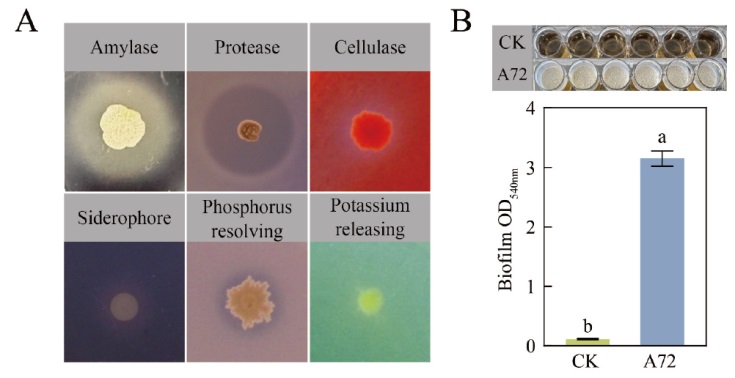
图2 B. siamensis A72的生理生化特性与生物膜形成能力 A:生理生化特性;B:生物膜形成能力。不同小写字母表示处理间差异显著(P<0.05),下同
Fig. 2 Physiological and biochemical characteristics and biofilm forming ability of B. siamensis A72 A: Determination of physiological and biochemical characteristics. B: Biofilm forming ability. The different lowercase letters indicate significant differences among treatments(P<0.05). The same below
| 试验项目 Test item | 结果 Result | 试验项目 Test item | 结果 Result | |
|---|---|---|---|---|
| 蛋白酶 Protease | + | 固氮 Nitrogen fixation | - | |
| 淀粉酶 Amylase | + | 解磷 Phosphorus resolving | + | |
| 纤维素酶 Cellulase | + | 解钾 Potassium releasing | + | |
| 铁载体 Siderophore | + | IAA产率 IAA production/(µg·mL-1) | 35.17±1.91 |
表1 B. siamensis A72的生理生化特性
Table 1 Physiological and biochemical characteristics of B. siamensis A72
| 试验项目 Test item | 结果 Result | 试验项目 Test item | 结果 Result | |
|---|---|---|---|---|
| 蛋白酶 Protease | + | 固氮 Nitrogen fixation | - | |
| 淀粉酶 Amylase | + | 解磷 Phosphorus resolving | + | |
| 纤维素酶 Cellulase | + | 解钾 Potassium releasing | + | |
| 铁载体 Siderophore | + | IAA产率 IAA production/(µg·mL-1) | 35.17±1.91 |
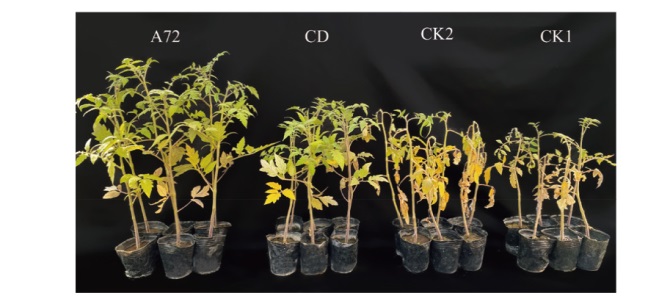
图3 不同处理中番茄幼苗接种青枯菌后的发病情况 CK1:清水+青枯病菌;CK2:无菌NB培养基+青枯病菌;CD:多菌灵+青枯病菌;A72:生防菌A72+青枯病菌
Fig. 3 Symptoms of tomato seedlings with R. solanacearum inoculation in different treatments CK1: Water + Ralstonia solanacearum; CK2: sterile NB medium + Ralstonia solanacearum; CD: carbendazim + Ralstonia solanacearum; A72: biological control strains A72 + Ralstonia solanacearum
| 处理 Treatment | 接种青枯菌后16 d after inoculation with Rs | 接种青枯菌后20 d after inoculation with Rs | ||||
|---|---|---|---|---|---|---|
| 病情指数Disease index | 防治效果Control efficiency/% | 病情指数Disease index | 防治效果Control efficiency/% | |||
| CK1 | 22.50±2.50 a | 35.00±5.00 b | ||||
| CK2 | 25.83±1.44 a | 48.33±5.77 a | ||||
| CD | 15.00±2.50 b | 42.12±7.06 a | 25.00±2.50 c | 48.48±6.15 b | ||
| A72 | 11.67±2.89 b | 55.15±8.40 a | 17.50±2.50 c | 63.80±2.78 a | ||
表2 B. siamensis A72对番茄青枯病的防病效果
Table 2 Control effect of B. siamensis A72 on tomato bacterial wilt
| 处理 Treatment | 接种青枯菌后16 d after inoculation with Rs | 接种青枯菌后20 d after inoculation with Rs | ||||
|---|---|---|---|---|---|---|
| 病情指数Disease index | 防治效果Control efficiency/% | 病情指数Disease index | 防治效果Control efficiency/% | |||
| CK1 | 22.50±2.50 a | 35.00±5.00 b | ||||
| CK2 | 25.83±1.44 a | 48.33±5.77 a | ||||
| CD | 15.00±2.50 b | 42.12±7.06 a | 25.00±2.50 c | 48.48±6.15 b | ||
| A72 | 11.67±2.89 b | 55.15±8.40 a | 17.50±2.50 c | 63.80±2.78 a | ||
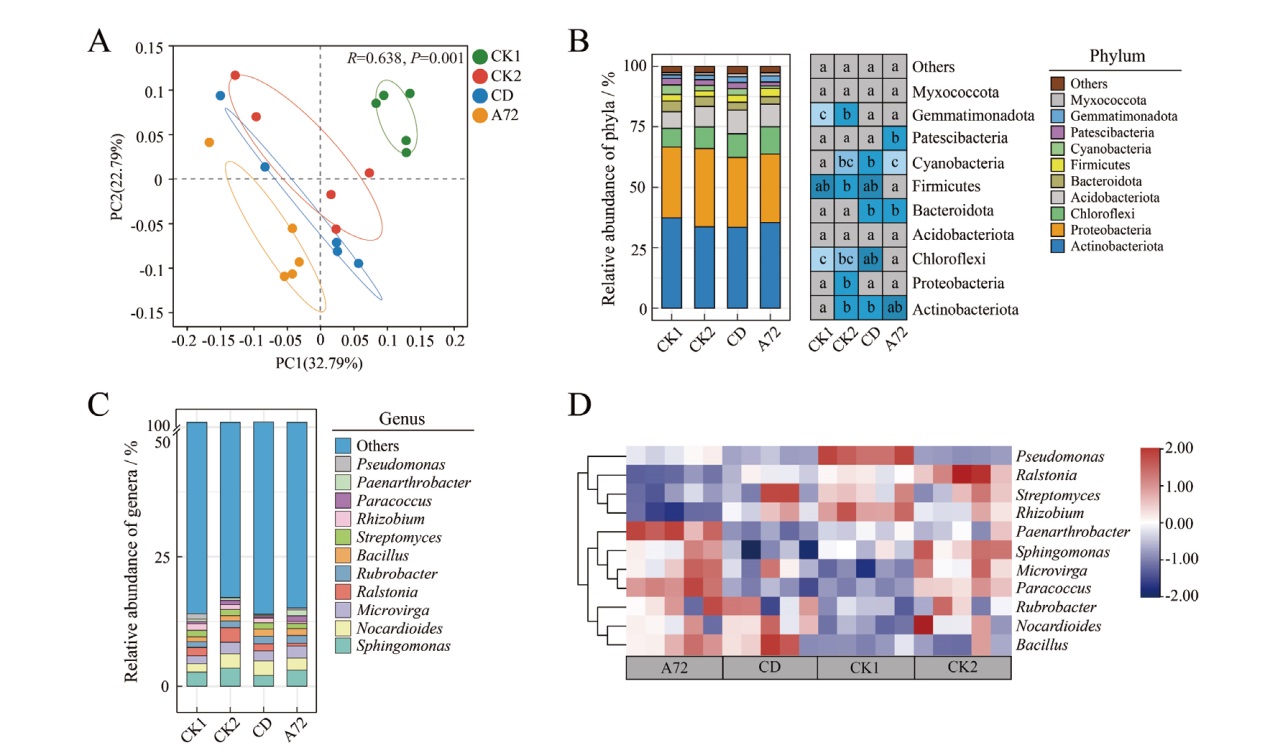
图4 不同处理中番茄根际细菌群落组成 A:基于 Bray-Curtis 距离的细菌群落的主坐标分析(PCoA);B:不同处理中门水平上的相对丰度(Student's t 检验, P<0.05);C:不同处理中属水平上的相对丰度;D:不同处理中细菌属的聚类分析热图
Fig. 4 Composition of bacterial communities in the tomato rhizosphere in different treatments A: Principal coordinate analysis of bacterial communities based on Bray-Curtis distance(PCoA). B: Relative abundance(%)of all bacterial phyla in different treatments(Student's t test, P<0.05). C: Relative abundance(%)of bacterial genera in different treatments. D: Heat map of cluster analysis of bacterial genera in different treatments

图5 不同处理中根际细菌属水平的丰度差异和线性判别分析(LEfSe) A:不同处理中根际细菌属水平的丰度差异分析(Wilcoxon秩和检验, P<0.05);B:不同处理中根际细菌属水平的线性判别分析(LDA≥2.5)
Fig. 5 Analysis of differential abundance and linear discriminant analysis(LEfSe)of rhizosphere bacterial genera in different treatments A: Analysis of differential abundance rhizosphere bacterial genera in different treatments(Wilcoxon Kruskal-Wallis, P<0.05). B: Linear discriminant analysis of rhizosphere bacterial genera in different treatments(LDA≥2.5)
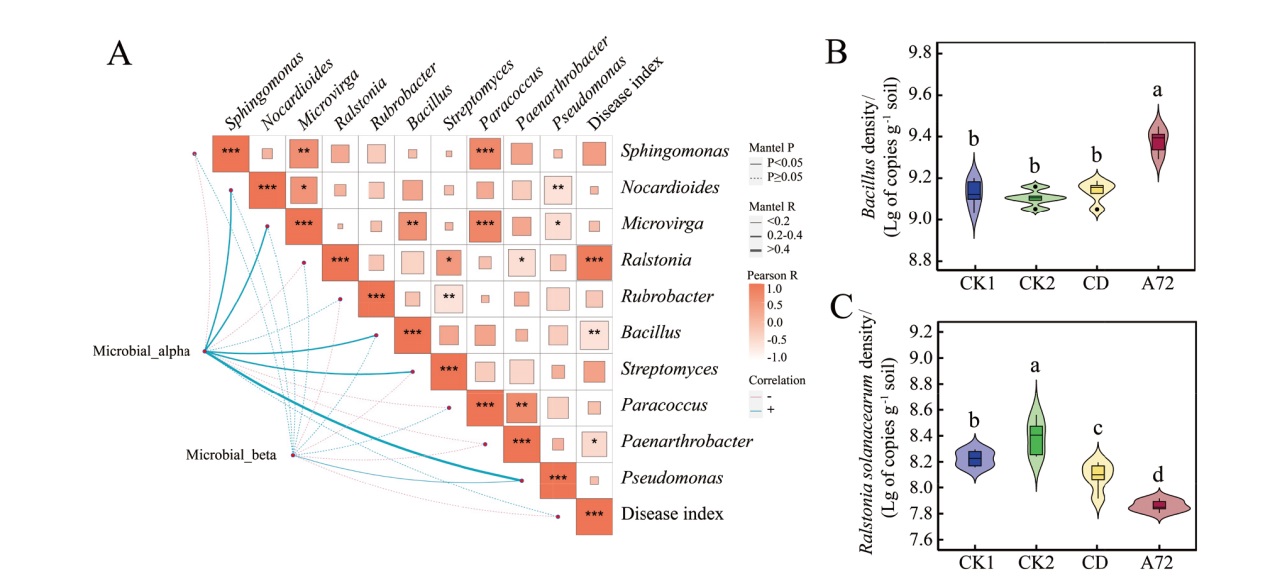
图6 根际细菌属与病情指数的相关性分析和根际芽胞杆菌属、茄科罗尔斯通氏菌绝对丰度 A:根据皮尔逊(Pearson)相关系数分析根际细菌属与病情指数的相关性;B:根际芽胞杆菌属的绝对丰度;C:根际茄科罗尔斯通氏菌的绝对丰度。热图对应的值为Pearson相关系数r,r>0 呈正相关,r<0 呈负相关。*,**,***分别表示在P<0.05,P<0.01,P<0.001水平存在显著性差异
Fig. 6 Analysis of correlation between rhizosphere bacterial genera and disease index, and absolute abundances of Bacillus and Ralstonia solanacearum in tomato rhizosphere A: The correlation between rhizosphere bacteria and disease index based on Pearson correlation coefficient. B: Absolute abundance of rhizosphere Bacillus. C: Absolute abundance of rhizosphere Ralstonia solanacearum. The corresponding value of the heat map is Pearson correlation coefficient r, where r > 0 is positive correlation and r < 0 is negative correlation. *, **, and *** indicate significant differences at P < 0.05, P < 0.01, and P < 0.001, respectively
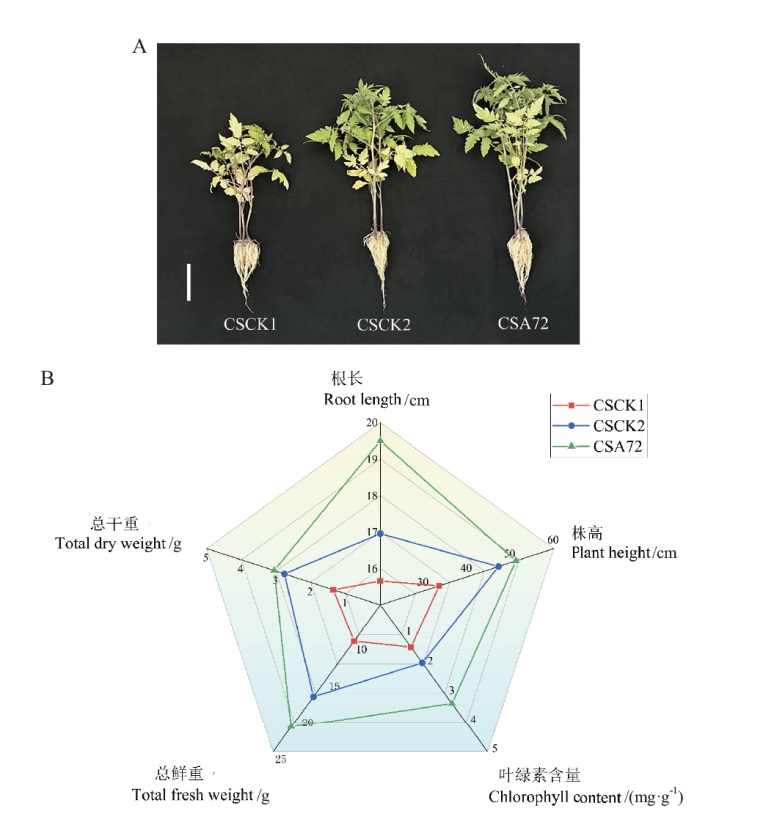
图7 菌株 A72 对番茄幼苗的促生效果(A)及综合能力评价(B) CSCK1:清水;CSCK2:无菌NB培养基;CSA72:菌悬液
Fig. 7 Growth promotion effect(A)and evaluation of comprehensive ability of strain A72 on tomato seedlings(bar=10 cm) CSCK1: Water; CSCK2: sterile NB medium; CSA72: bacterial suspension
| [1] | 李志丹, 黄奇, 林刿, 等. 利迪链霉菌 M01 对番茄生长、青枯病发病率及根际细菌群落组成的影响[J]. 微生物学通报, 2023, 50(6): 2508-2518. |
| Li ZD, Huang Q, Lin G, et al. Effects of Streptomyces lydicus M01 on growth, bacterial wilt incidence, and rhizosphere bacterial community composition of tomatoes[J]. Microbiology China, 2023, 50(6): 2508-2518. | |
| [2] |
吴思炫, 高复云, 张锐澎, 等. 番茄青枯病生物防治的研究进展[J]. 应用生态学报, 2023, 34(9): 2585-2592.
doi: 10.13287/j.1001-9332.202309.028 |
|
Wu SX, Gao FY, Zhang RP, et al. Research progress in biological control of tomato bacterial wilt[J]. Chin J Appl Ecol, 2023, 34(9): 2585-2592.
doi: 10.13287/j.1001-9332.202309.028 |
|
| [3] |
Jiang GF, Wei Z, Xu J, et al. Bacterial wilt in China: history, current status, and future perspectives[J]. Front Plant Sci, 2017, 8: 1549.
doi: 10.3389/fpls.2017.01549 pmid: 28955350 |
| [4] | Rivera-Zuluaga K, Hiles R, Barua P, et al. Getting to the root of Ral-stonia invasion[J]. Semin Cell Dev Biol, 2023, 148/149: 3-12. |
| [5] | 王梅, 尹显慧, 龙友华, 等. 几种杀菌剂对番茄青枯病菌的毒力测定及田间药效[J]. 江苏农业科学, 2015, 43(4): 151-153. |
| Wang M, Yin XH, Long YH, et al. Toxicity determination and field efficacy of several fungicides against tomato bacterial wilt[J]. Jiangsu Agric Sci, 2015, 43(4): 151-153. | |
| [6] |
陈远松, 朱晓伟, 龚翔宇, 等. 分子标记在我国番茄抗病育种的应用研究进展[J]. 浙江农业学报, 2017, 29(8): 1415-1420.
doi: 10.3969/j.issn.1004-1524.2017.08.25 |
|
Chen YS, Zhu XW, Gong XY, et al. Research advance of molecular marker-assisted selection in tomato disease resistance breeding in China[J]. Acta Agric Zhejiangensis, 2017, 29(8): 1415-1420.
doi: 10.3969/j.issn.1004-1524.2017.08.25 |
|
| [7] | 徐欣韵, 王宁, 丁佳, 等. 番茄青枯病拮抗菌的定向筛选及其抗病促生机制研究[J]. 微生物学报, 2021, 61(10): 3276-3290. |
| Xu XY, Wang N, Ding J, et al. Isolation and identification of antagonistic bacteria against tomato bacterial wilt and the mechanisms in disease prevention and plant growth promotion[J]. Acta Microbiol Sin, 2021, 61(10): 3276-3290. | |
| [8] | Chowdhury SP, Dietel K, Rändler M, et al. Effects of Bacillus am-yloliquefaciens FZB42 on lettuce growth and health under pathogen pressure and its impact on the rhizosphere bacterial community[J]. PLoS One, 2013, 8(7): e68818. |
| [9] | Yang BY, Zheng MZ, Dong WP, et al. Plant disease resistance-related pathways recruit beneficial bacteria by remodeling root exudates upon Bacillus cereus AR156 treatment[J]. Microbiol Spectr, 2023, 11(2): e0361122. |
| [10] | Ahmed W, Dai ZL, Zhang JH, et al. Plant-microbe interaction: mining the impact of native Bacillus amyloliquefaciens WS-10 on tobacco bacterial wilt disease and rhizosphere microbial communities[J]. Microbiol Spectr, 2022, 10(4): e0147122. |
| [11] | 秦菁菁, 曹璐, 付威, 等. 拮抗两种辣椒病害的菌株鉴定及生防潜力评价[J]. 微生物学通报, 2024, 51(7): 2450-2462. |
| Qin JJ, Cao L, Fu W, et al. Identification and biocontrol potential of a strain against two pepper diseases[J]. Microbiology China, 2024, 51(7): 2450-2462. | |
| [12] | 王琦, 陈秀玲, 王傲雪. 一株具有促生作用的生防细菌YN-2A的分离、鉴定及全基因组测序分析[J]. 微生物学通报, 2024: 1-18. |
| Wang Q, Chen XL, Wang AX. A biocontrol bacterium YN-2A with growth-promoting effect: isolation, identification, and genome sequencing[J]. Microbiology China, 2024: 1-18. | |
| [13] |
Andreote FD, Pereira E Silva MC. Microbial communities associated with plants: learning from nature to apply it in agriculture[J]. Curr Opin Microbiol, 2017, 37: 29-34.
doi: S1369-5274(17)30014-0 pmid: 28437663 |
| [14] | 沈萍, 陈向东. 微生物学实验[M]. 4版. 北京: 高等教育出版社, 2007. |
| Shen P, Chen XD. Microbiological experiment[M]. 4th ed. Beijing: Higher Education Press, 2007. | |
| [15] | 杨革. 微生物学实验教程[M]. 北京: 科学出版社, 2004. |
| Yang G. Microbiology experiment course[M]. Beijing: Science Press, 2004. | |
| [16] | 章梦婷, 王二兴, 张雅婷, 等. 黄瓜根际促生菌Bacillus subti-lis S1的分离鉴定与促生抗病[J]. 微生物学通报, 2024, 51(6): 2141-2157. |
| Zhang MT, Wang EX, Zhang YT, et al. Isolation and characterization of Bacillus subtilis S1 capable of inducing resistance against powdery mildew and promoting cucumber growth from cucumber rhizosphere[J]. Microbiology China, 2024, 51(6): 2141-2157. | |
| [17] | 张盈盈, 安晓霞, 马春晖, 等. 解磷细菌与磷肥耦合提高苜蓿生长及光合性能[J]. 中国草地学报, 2023, 45(11): 43-51. |
| Zhang YY, An XX, Ma CH, et al. The coupling of phosphate solubilizing bacteria and phosphate fertilizer to improve the growth and photosynthetic performance of alfalfa[J]. Chin J Grassland, 2023, 45(11): 43-51. | |
| [18] | Wu X, Xie Y, Qiao J, et al. Rhizobacteria strain from a hypersaline environment promotes plant growth of Kengyilia thoroldiana[J]. Microbiology, 2019, 88(2): 220-231. |
| [19] | Rajawat MVS, Singh S, Tyagi SP, et al. A modified plate assay for rapid screening of potassium-solubilizing bacteria[J]. Pedosphere, 2016, 26(5): 768-773. |
| [20] |
冯路遥, 赵江源, 施竹凤, 等. 森林根际土壤细菌的分离、鉴定及生物活性筛选[J]. 生物技术通报, 2024, 40(1): 294-307.
doi: 10.13560/j.cnki.biotech.bull.1985.2023-0586 |
| Feng LY, Zhao JY, Shi ZF, et al. Isolation, characterization and bioactivity screening of forest inter-root soil bacteria[J]. Biotechnology Bulletin, 2024, 40(1): 294-307. | |
| [21] | 张东艳, 刘晔, 吴越, 等. 花生根际产IAA菌的筛选鉴定及其效应研究[J]. 中国油料作物学报, 2016, 38(1): 104-110. |
| Zhang DY, Liu Y, Wu Y, et al. Isolation and identification of IAA-producing strains from peanut rhizosphere and its promoting effects on peanut growth[J]. Chin J Oil Crop Sci, 2016, 38(1): 104-110. | |
| [22] | Lee SM, Kong HG, Song GC, et al. Disruption of firmicutes and actinobacteria abundance in tomato rhizosphere causes the incidence of bacterial wilt disease[J]. ISME J, 2021, 15(1): 330-347. |
| [23] | 刘明艳, 马嘉晗, 李瑜, 等. 16S rRNA基因高变区V4和V3-V4及测序深度对油藏细菌菌群分析的影响[J]. 微生物学通报, 2020, 47(2): 440-449. |
| Liu MY, Ma JH, Li Y, et al. Influence of 16S rRNA gene V4 and V3-V4 sequencing and sequencing depth on unraveling bacterial communities inhabiting oil reservoirs[J]. Microbiol China, 2020, 47(2): 440-449. | |
| [24] | Mori K, Iriye R, Hirata M, et al. Quantification ofBacillus species in a wastewater treatment system by the molecular analyses[J]. Biotechnol Bioprocess Eng, 2004, 9(6): 482-489. |
| [25] | Schönfeld J, Heuer H, Van Elsas JD, et al. Specific and sensitive detection of Ralstonia solanacearum in soil on the basis of PCR amplification of fliC fragments[J]. Appl Environ Microbiol, 2003, 69(12): 7248-7256. |
| [26] | 努尔凯麦尔·木拉提, 杨亚杰, 帕尔哈提·阿布都克日木, 等. 小麦叶绿素含量测定方法比较[J]. 江苏农业科学, 2021, 49(9): 156-159. |
| Nuerkaimaier MLT, Yang YJ, Paerhati ABDKRM, et al. Comparison of determination methods of chlorophyll content in wheat[J]. Jiangsu Agric Sci, 2021, 49(9): 156-159. | |
| [27] | 张韫. 土壤·水·植物理化分析教程[M]. 北京: 中国林业出版社, 2011. |
| Zhang Y. Course of soil, water and plant physical and chemical analysis[M]. Beijing: China Forestry Publishing House, 2011. | |
| [28] | 牛义岭, 商丽敏. 番茄青枯病的发生及防治[J]. 现代农业科技, 2023(12): 100-102, 108. |
| Niu YL, Shang LM. Occurrence and control of tomato bacterial wilt[J]. Mod Agric Sci Technol, 2023(12): 100-102, 108. | |
| [29] | Bonaterra A, Badosa E, Daranas N, et al. Bacteria as biological control agents of plant diseases[J]. Microorganisms, 2022, 10(9): 1759. |
| [30] | Yin JK, Zhang ZL, Zhu CC, et al. Heritability of tomato rhizobacteria resistant to Ralstonia solanacearum[J]. Microbiome, 2022, 10(1): 227. |
| [31] | Li CY, Hu WC, Pan B, et al. Rhizobacterium Bacillus amyloliq-uefaciens strain SQRT3-mediated induced systemic resistance controls bacterial wilt of tomato[J]. Pedosphere, 2017, 27(6): 1135-1146. |
| [32] | 韦中. 生物有机肥防控土传番茄青枯病的效果及其机制研究[D]. 南京: 南京农业大学, 2012. |
| Wei Z. Study on the effect and mechanism of bio-organic fertilizer in controlling soil-borne tomato bacterial wilt[D]. Nanjing: Nanjing Agricultural University, 2012. | |
| [33] |
王芳, 于璐, 齐泽铮, 等. 大豆镰刀菌根腐病拮抗菌的筛选及生防效果[J]. 生物技术通报, 2024, 40(7): 216-225.
doi: 10.13560/j.cnki.biotech.bull.1985.2024-0070 |
|
Wang F, Yu L, Qi ZZ, et al. Screening and biocontrol effect of antagonistic bacteria against soybean root rot[J]. Biotechnology Bulletin, 2024, 40(7): 216-225.
doi: 10.13560/j.cnki.biotech.bull.1985.2024-0070 |
|
| [34] | 曾婉宁, 王彦譞, 王繁珍, 等. 暹罗芽孢杆菌Y-54对番茄叶霉病的生防作用[J]. 河南农业科学, 2024, 53(3): 103-109. |
| Zeng WN, Wang YX, Wang FZ, et al. Biocontrol effect of Bacillus Siamese Y-54 on tomato leaf mold[J]. J Henan Agric Sci, 2024, 53(3): 103-109. | |
| [35] |
曹云娥, 吴庆, 张美君, 等. 瓜类枯萎病生防菌WQ-6的筛选鉴定、发酵工艺优化及防效研究[J]. 园艺学报, 2020, 47(6): 1072-1086.
doi: 10.16420/j.issn.0513-353x.2019-0925 |
| Cao YE, Wu Q, Zhang MJ, et al. Screening, identification and optimization of fermentation conditions of biocontrol strain WQ-6 to melon Fusarium wilt disease[J]. Acta Hortic Sin, 2020, 47(6): 1072-1086. | |
| [36] | 王位, 薛鸣, 雷婷越, 等. 番茄青枯病拮抗菌的筛选及防治效果[J]. 海南大学学报: 自然科学版, 2024, 42(1): 30-36. |
| Wang W, Xue M, Lei TY, et al. Screening and control effect of antagonistic bacteria against tomato bacterial wilt[J]. Nat Sci J Hainan Univ, 2024, 42(1): 30-36. | |
| [37] |
Rooijakkers SHM, van Strijp JAG. Bacterial complement evasion[J]. Mol Immunol, 2007, 44(1-3): 23-32.
pmid: 16875737 |
| [38] |
Passari AK, Mishra VK, Leo VV, et al. Phytohormone production endowed with antagonistic potential and plant growth promoting abilities of culturable endophytic bacteria isolated from Cleroden-drum colebrookianum Walp[J]. Microbiol Res, 2016, 193: 57-73.
doi: S0944-5013(16)30306-8 pmid: 27825487 |
| [39] |
Chen Y, Yan F, Chai YR, et al. Biocontrol of tomato wilt disease by Bacillus subtilis isolates from natural environments depends on conserved genes mediating biofilm formation[J]. Environ Microbiol, 2013, 15(3): 848-864.
doi: 10.1111/j.1462-2920.2012.02860.x pmid: 22934631 |
| [40] | Durairaj K, Velmurugan P, Park JH, et al. Potential for plant biocontrol activity of isolated Pseudomonas aeruginosa and Bacillus stratosphericus strains against bacterial pathogens acting through both induced plant resistance and direct antagonism[J]. FEMS Microbiol Lett, 2017, 364(23): 10.1093/femsle/fnx225. |
| [41] | Deng XH, Zhang N, Li YC, et al. Bio-organic soil amendment promotes the suppression of Ralstonia solanacearum by inducing changes in the functionality and composition of rhizosphere bacterial communities[J]. New Phytol, 2022, 235(4): 1558-1574. |
| [42] | Kwak MJ, Kong HG, Choi K, et al. Rhizosphere microbiome structure alters to enable wilt resistance in tomato[J]. Nat Biotechnol, 2018, 36(11): 1117. |
| [43] |
王晓楠, 冯晓晓, 施斌, 等. 内生细菌ZN-S10的鉴定及其对番茄青枯病菌的抑菌作用[J]. 浙江农业学报, 2023, 35(11): 2636-2644.
doi: 10.3969/j.issn.1004-1524.20230864 |
| Wang XN, Feng XX, Shi B, et al. Identification of Bacillus velezen-sis ZN-S10 and its antification effect on tomato bacterial wilt[J]. Acta Agric Zhejiangensis, 2023, 35(11): 2636-2644. | |
| [44] |
Weller DM, Raaijmakers JM, Gardener BB, et al. Microbial populations responsible for specific soil suppressiveness to plant pathogens[J]. Annu Rev Phytopathol, 2002, 40: 309-348.
pmid: 12147763 |
| [45] | Wen T, Zhao ML, Liu T, et al. High abundance of Ralstonia sola-nacearum changed tomato rhizosphere microbiome and metabolome[J]. BMC Plant Biol, 2020, 20(1): 166. |
| [46] | Li JY, Zhao QQ, Wuriyanghan H, et al. Biocontrol bacteria strains Y4 and Y8 alleviate tobacco bacterial wilt disease by altering their rhizosphere soil bacteria community[J]. Rhizosphere, 2021, 19: 100390. |
| [47] | Zhang ZY, Li J, Zhang ZQ, et al. Tomato endophytic bacteria composition and mechanism of suppressiveness of wilt disease(Fusar-ium oxysporum)[J]. Front Microbiol, 2021, 12: 731764. |
| [1] | 刘倩, 马连杰, 张慧, 王冬, 范茂, 廖敦秀, 赵正武, 卢文才. 辣椒炭疽病生防菌株TN2的筛选鉴定与抑菌效果[J]. 生物技术通报, 2025, 41(1): 287-297. |
| [2] | 王美玲, 耿丽丽, 房瑜, 束长龙, 张杰. 苏云金芽胞杆菌4BM1菌株对油菜菌核病的防治潜力[J]. 生物技术通报, 2024, 40(9): 260-269. |
| [3] | 王芳, 于璐, 齐泽铮, 周长军, 于吉东. 大豆镰刀菌根腐病拮抗菌的筛选及生防效果[J]. 生物技术通报, 2024, 40(7): 216-225. |
| [4] | 范宗强, 冯靖涵, 郑丽雪, 王硕, 彭向前, 陈芳. 枯草芽孢杆菌B579对黄瓜枯萎病的防治及其诱导抗性研究[J]. 生物技术通报, 2024, 40(7): 226-234. |
| [5] | 徐伟芳, 李贺宇, 张慧, 何仔昂, 高文恒, 谢紫洋, 王传文, 尹登科. 生防细菌HX0037对栝楼炭疽病的防病能力及其机制[J]. 生物技术通报, 2024, 40(4): 228-241. |
| [6] | 许沛冬, 易剑锋, 陈迪, 潘磊, 谢丙炎, 赵文军. 贝莱斯芽孢杆菌生防次级代谢产物研究进展[J]. 生物技术通报, 2024, 40(3): 75-88. |
| [7] | 丁艳哲, 姚鑫鑫, 孙卓, 杨利民, 韩忠明, 王云贺. 刺五加黑斑病生防细菌分离、鉴定、优选及发酵条件优化[J]. 生物技术通报, 2024, 40(12): 218-226. |
| [8] | 叶柳健, 贺愉岚, 王小虎, 韦圣博, 何双, 朱绮霞, 卢洁, 周礼芹. 解淀粉芽孢杆菌YK3对沃柑溃疡病的防效及叶际细菌群落相关性的影响[J]. 生物技术通报, 2024, 40(11): 248-258. |
| [9] | 李希, 边子俊, 宁周神, 刘红雨, 曾槟, 董伟. 离子型稀土矿根际芽孢杆菌的促生作用研究[J]. 生物技术通报, 2024, 40(11): 259-268. |
| [10] | 马云涛, 胡丽娜, 孙文婧, 唐莲庚, 孙思远, 邓欣雨, 孙黎. 梨火疫病拮抗菌JK2的筛选鉴定及发酵条件优化[J]. 生物技术通报, 2024, 40(11): 202-213. |
| [11] | 王俊芳, 黄秋斌, 张飘丹, 张彭湃. Surfactin的结构、生物合成及其在生物防治中的作用[J]. 生物技术通报, 2024, 40(1): 100-112. |
| [12] | 褚睿, 李昭轩, 张学青, 杨东亚, 曹行行, 张雪艳. 黄瓜枯萎病拮抗芽孢杆菌的筛选、鉴定及其生防潜力[J]. 生物技术通报, 2023, 39(8): 262-271. |
| [13] | 任沛东, 彭健玲, 刘圣航, 姚姿婷, 朱桂宁, 陆光涛, 李瑞芳. 沙福芽孢杆菌GX-H6的分离鉴定及对水稻细菌性条斑病的防病效果[J]. 生物技术通报, 2023, 39(5): 243-253. |
| [14] | 章乐乐, 王冠, 柳凤, 胡汉桥, 任磊. 芒果炭疽病拮抗菌分离、鉴定及生防机制研究[J]. 生物技术通报, 2023, 39(4): 277-287. |
| [15] | 易希, 廖红东, 郑井元. 植物内生真菌防治根结线虫研究进展[J]. 生物技术通报, 2023, 39(3): 43-51. |
| 阅读次数 | ||||||
|
全文 |
|
|||||
|
摘要 |
|
|||||